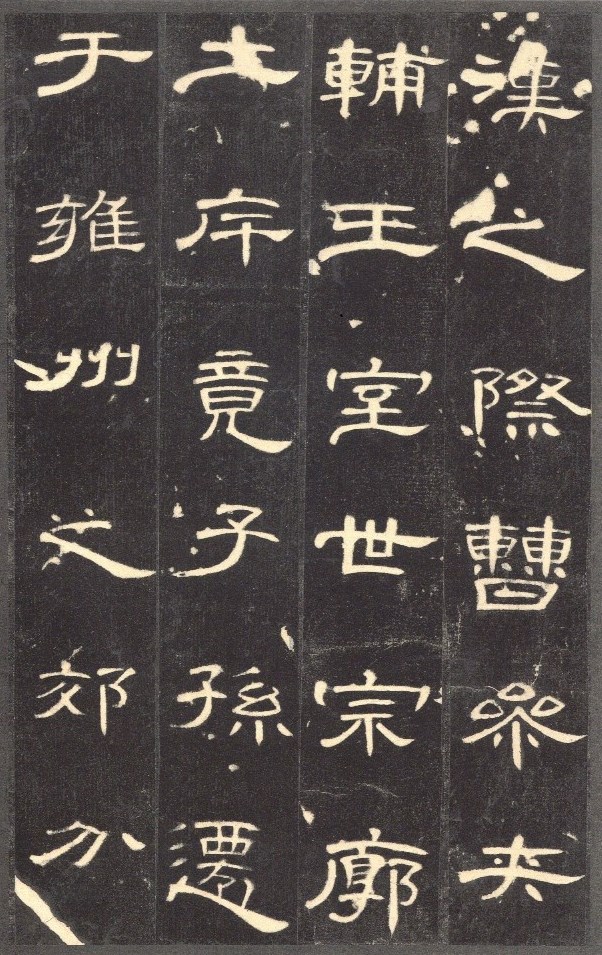Cao Quan Bei (Stele) 曹全碑 is a stone stele erected in 185 AD in memory of the contributions of a local official named Cao Quan. This stele is one of the best preserved stone inscriptions of the Eastern Han Dynasty. Buried soon after its erection, it was not unearthed until 1573. The delicacy of its brushstrokes was preserved and remain clearly discernible.

A quick overview of the contents of the stele
Cao Quan 曹全 was a descendant of a highly educated and respectable family and his ancestors held important offices in the government.
Since childhood, Cao Quan studied extensively. Filial piety was in his nature and he cared for his grand auntie and also his stepmother. He took various offices in the government. Being upright and uncorrupted, he set a role model and inspired his colleague. He also rectified the wrong behaviour of others. He was highly respected. Besides coordinating administrative work in the government, Cao was also competent in military operations with good plans and strategies. He conquered and pacified the alien land (征鬼方, 安殊巟). He treated his troops with great benevolence and generosity. He personally helped injured soldier to drain the pus in the wounds (兗膿之仁). He shared his wine with the troops (分醪之惠).
In 183 AD the atrocious felon Zhang Jue (張角) revolted against the government causing riots and tumult in various provinces displacing large populations of people from their homes. The Emperor appointed Cao Quan to the position of County Magistrate of He-yang (郃陽令) to fight against the rebels. Eventually the rebels were wiped out by Cao. Law and orders were restored and people returned home. Cao empathised with the needs of the people using his own money to buy grains and rice for the needy.
Cao also repaired and restored walls and houses. He coordinated various large projects such as building the inner and outer city walls.
Cao also promoted suitable people to higher government positions.
In 185, this stone stele was inscribed to document his accomplishments.
Translations
Mr Vincent Poon & Dr Kwok Kin Poon meticulously translated the whole text sentence by sentence into English. Their scholarly translation was published in 2019 (ISBN 978-1-98485-02-6, www.thesenseis.com). I highly recommend readers to get a copy to study about this stele.
Chinese translation into present day language can be found in 俞丰 (2009),經典碑帖釋文譯注(ISBN 978-7-80725-846-9) and
https://www.easyatm.com.tw/wiki/%E6%9B%B9%E5%85%A8%E7%A2%91 (曹全碑)
Original Text in Classical Chinese
君諱全,字景完,敦煌效穀人也。其先蓋周之胄,武王秉乾之機,翦伐殷商,既定爾勳,福祿攸同,封弟叔振鐸于曹國,因氏焉。秦漢之際,曹參夾輔王室。世宗廓土斥竟,子孫遷于雍州之郊,分止右扶風,或在安定,或處武都,或居隴西,或家敦煌,枝分葉布,所在為雄。
君高祖父敏,舉孝廉,武威長史、巴郡朐忍令、張掖居延都尉。曾祖父述,孝廉,謁者、金城長史、夏陽令、蜀郡西部都尉。祖父鳳,孝廉,張掖屬國都尉丞、右扶風隃麋侯相、金城西部都尉、北地大守。父琫,少貫名州郡,不幸早世,是以位不副德。
君童齔好學,甄極毖緯,無文不綜。賢孝之性,根生於心,收養季祖母,供事繼母,先意承志,存亡之敬,禮無遺闕,是以鄉人為之諺曰:「重親致歡曹景完。」易世載德,不隕其名。及其從政,清擬夷齊,直慕史魚,歷郡右職,上計掾史,仍辟涼州,常為治中、別駕,紀綱萬里,朱紫不謬。出典諸郡,彈枉糾邪,貪暴洗心,同僚服德,遠近憚威。建寧二年,舉孝廉,除郎中,拜西域戊部司馬。時疏勒國王和德,弒父篡位,不供職貢,君興師征討,有兗膿之仁,分醪之惠。攻城野戰,謀若湧泉,威牟諸賁,和德面縛歸死。還師振旅,諸國禮遺,且二百萬,悉以簿官。遷右扶風槐里令。遭同產弟憂,棄官。續遇禁罔,潛隱家巷七年。
光和六年,復舉孝廉。七年三月,除郎中,拜酒泉祿福長。訞賊張角起兵,幽、冀、兗、豫、荊、楊同時並動。而縣民郭家等復造逆亂,燔燒城寺,萬民騷擾,人褱(懷)不安。三郡告急,羽檄仍至。于時聖主咨諏群僚,咸曰:「君哉!」,轉拜郃陽令,收合餘燼,芟夷殘迸,絕其本根。遂訪故老,商量㑺艾王敞、王畢等,恤民之要,存慰高年,撫育鰥寡,以家錢糴米粟,賜癃盲。大女桃婓等,合七首藥神明膏,親至離亭,部吏王皐、程橫等,賦與有疾者,咸蒙瘳悛。惠政之流,甚於置郵。百姓繦負,反者如雲。戢治廧屋,市肆列陳。風雨時節,歲獲豐年,農夫織婦,百工戴恩。
縣前以河平元年遭白茅谷水災,害退於戌亥之間,興造城郭。是後,舊姓及修身之士官位不登,君乃閔縉紳之徒不濟,開南寺門,承望華嶽,鄉明而治。庶使學者李儒、欒規、程寅等,各獲人爵之報。廓廣聽事官舍,廷曹廊閤,升降揖讓朝覲之階,費不出民,役不干時。門下掾王敞、錄事掾王畢、主簿王歷、戶曹掾秦尚、功曹史王顓等,嘉慕奚斯,考甫之美,乃共刊石紀功,其辭曰:
懿明后,德義章。貢王庭,征鬼方。威布烈,安殊巟。還師旅,臨槐里。感孔懷,赴喪紀。嗟逆賊,燔城市。特受命,理殘圮。芟不臣,寧黔首。繕官寺,開南門。闕嵯峨,望華山。鄉明治,惠沾渥。吏樂政,民給足。君高升,極鼎足。
中平二年十月丙辰造。
My copy of the full text of the stele is as follows.
Please just use this copy as a reference. Always learn and copy from the rubbings of the original stele.
Misconceptions
Some people think that the scripts of Cao Quan Bei are beautiful but weak and fragile. They fail to appreciate the ‘strength’ of the strokes. Every stroke shows strength and determination. An analogy is the ribbon dance and may I invite you to watch a short video of ‘ribbon dance’ :
https://youtu.be/wkEyMLvb4nw (Li HongYang Ribbon 李紅楊絲帶操_2008 全國藝術體操冠軍賽)
The elegant movements of ribbons must be built on the muscular strength of the dancer. Without muscular strength, it is impossible to achieve the movements of the ribbons. The ribbons also greatly expands the expressive power of the dancer’s body and movements and allows emotional expression to become yet more vivid.
Similarly the long and delicate strokes of Cao Quan Bei are built on accurate and firm control of the brush, underlined by the inner strength of the calligrapher. The elegance of the strokes also allow emotional expression to become more vivid.
Bibliography
https://www.easyatm.com.tw/wiki/%E6%9B%B9%E5%85%A8%E7%A2%91 (曹全碑)
俞丰 (2009),經典碑帖釋文譯注 上海書畫出版社 (ISBN 978-7-80725-846-9)
Vincent Poon & Kwok Kin Poon (2019) English Translation of Classical Chinese Calligraphy Masterpieces. The SeneSeis (ISBN 978-1-98485-02-6)
.


















